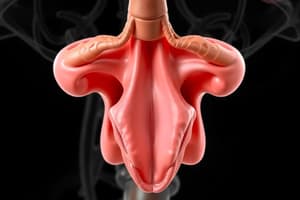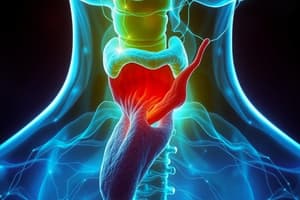Podcast
Questions and Answers
(1/3) A 6 year old FS poodle presents with PU/PD, pot belly, polyphagia, and muscle wasting. Her CBC shows a stress leukogram and erythrocytosis. The serum chemistry shows increased ALP and ALT, hypertriglyceridemia, and increased bile acids. Her systolic blood pressure reads as 172 mmHg. What is the most likely diagnosis?
(1/3) A 6 year old FS poodle presents with PU/PD, pot belly, polyphagia, and muscle wasting. Her CBC shows a stress leukogram and erythrocytosis. The serum chemistry shows increased ALP and ALT, hypertriglyceridemia, and increased bile acids. Her systolic blood pressure reads as 172 mmHg. What is the most likely diagnosis?
- Addison's disease
- Diabetes Mellitus
- Cushing's disease (correct)
- Chronic liver disease
(2/3) Continuing the case from question 1, you decide to run a low dose dexamethasone suppression test (LDDST) based on your suspicion of Cushing's disease. Your results are as follows: 8 hr sample > lab cut off, 4 hr sample > lab cut off. What do these results indicate?
(2/3) Continuing the case from question 1, you decide to run a low dose dexamethasone suppression test (LDDST) based on your suspicion of Cushing's disease. Your results are as follows: 8 hr sample > lab cut off, 4 hr sample > lab cut off. What do these results indicate?
- These results are consistent with pituitary dependent hyperadrenocorticism
- These results are not consistent with pituitary dependent hyperadrenocorticism
- These results are consistent with an adrenal tumor
- These results could indicate either pituitary dependent hyperadrenocorticism or an adrenal tumor. Further testing is needed (correct)
(3/3) Based on the results from question 2, you decide to run a high dose dexamethasone test (HHDST) to determine if this dog has PDH or AT. Your 8 hr sample is > the lab cut off, your 4 hr and 8 hr sample is < 50% baseline. What is your diagnosis based on these results?
(3/3) Based on the results from question 2, you decide to run a high dose dexamethasone test (HHDST) to determine if this dog has PDH or AT. Your 8 hr sample is > the lab cut off, your 4 hr and 8 hr sample is < 50% baseline. What is your diagnosis based on these results?
- Adrenal tumor
- Pituitary dependent hyperadrenocorticism (correct)
What is the only test that can be used to definitively diagnose pituitary dependent hyperadrenocorticism (PDH)?
What is the only test that can be used to definitively diagnose pituitary dependent hyperadrenocorticism (PDH)?
(1/3) A 7 year old MC standard poodle presents to your clinic for lethargy, vomiting, diarrhea, anorexia, and PU/PD. He is bradycardic with poor pulse quality, dehydrated, and hypothermic. The CBC does not show a stress leukogram, but lymphocytosis is appreciated. His serum chemistry shows hyperkalemia, azotemia,and hyponatremia. Based on these findings, what is the most likely diagnosis?
(1/3) A 7 year old MC standard poodle presents to your clinic for lethargy, vomiting, diarrhea, anorexia, and PU/PD. He is bradycardic with poor pulse quality, dehydrated, and hypothermic. The CBC does not show a stress leukogram, but lymphocytosis is appreciated. His serum chemistry shows hyperkalemia, azotemia,and hyponatremia. Based on these findings, what is the most likely diagnosis?
(2/3) Based on your answer from question 5, what test would you like to run next?
(2/3) Based on your answer from question 5, what test would you like to run next?
(3/3) You decide to run an ACTH stimulation test based on your suspicion of Addison's disease. You give synthetic ACTH and recheck in 1 hour. Your results show no response to the synthetic ACTH given. Does this confirm your suspected diagnosis of Addison's disease?
(3/3) You decide to run an ACTH stimulation test based on your suspicion of Addison's disease. You give synthetic ACTH and recheck in 1 hour. Your results show no response to the synthetic ACTH given. Does this confirm your suspected diagnosis of Addison's disease?
What test is best for diagnosing aldosterone deficiency?
What test is best for diagnosing aldosterone deficiency?
What is the drug of choice for long term management of Addison's disease?
What is the drug of choice for long term management of Addison's disease?
(1/3) A 3 year old FS lab presents for lethargy, weight gain, and a poor coat. The CBC shows normocytic normochromic non-regenerative anemia. Her chemistry shows hypercholesterolemia and hypertriglyceridemia on a fasted sample. Based on the signalment and lab findings, what is the most likely diagnosis?
(1/3) A 3 year old FS lab presents for lethargy, weight gain, and a poor coat. The CBC shows normocytic normochromic non-regenerative anemia. Her chemistry shows hypercholesterolemia and hypertriglyceridemia on a fasted sample. Based on the signalment and lab findings, what is the most likely diagnosis?
(2/3) You suspect hypothryoidism for your lab patients. Which of these diagnostic tests would be the best at confirming this diagnosis?
(2/3) You suspect hypothryoidism for your lab patients. Which of these diagnostic tests would be the best at confirming this diagnosis?
(3/3) What is the recommended treatment option for hypothyroidism?
(3/3) What is the recommended treatment option for hypothyroidism?
Weight loss with polyphagia is characteristic of which of these endocrine diseases?
Weight loss with polyphagia is characteristic of which of these endocrine diseases?
Which of these statements regarding hyperthyroidism is false?
Which of these statements regarding hyperthyroidism is false?
Which of the following organ systems is not involved in maintaining calcium homeostasis?
Which of the following organ systems is not involved in maintaining calcium homeostasis?
Which of the following is not a cause of hypercalcemia?
Which of the following is not a cause of hypercalcemia?
Which of these findings would be consistent with hypoparathyroidism?
Which of these findings would be consistent with hypoparathyroidism?
True or False: Calcium gluconate can be given IV.
True or False: Calcium gluconate can be given IV.
Ferrets with insulinoma who present with signs such as slowing down, hind limb weakness, staring off into space, lethargy, and exercise intolerance have ____ neuroglycopenia.
Ferrets with insulinoma who present with signs such as slowing down, hind limb weakness, staring off into space, lethargy, and exercise intolerance have ____ neuroglycopenia.
Which of the following statements about insulinoma in ferrets is false?
Which of the following statements about insulinoma in ferrets is false?
What is the treatment of choice for adrenocortical disease in ferrets?
What is the treatment of choice for adrenocortical disease in ferrets?
Which of these statements is true regarding adrenal surgery?
Which of these statements is true regarding adrenal surgery?
Which of these statements about thyroidectomy is false?
Which of these statements about thyroidectomy is false?
All of the following are clinical signs of post-op parathyroidectomy that should be monitored EXCEPT:
Soft tissue likes to ask this on clinics FYI
All of the following are clinical signs of post-op parathyroidectomy that should be monitored EXCEPT: Soft tissue likes to ask this on clinics FYI
How does insulinoma differ in dogs in comparison to ferrets?
How does insulinoma differ in dogs in comparison to ferrets?
Up to ____% of the pancreas can be removed w/o impacting endocrine and exocrine function, unless pre-existing condition is present.
Up to ____% of the pancreas can be removed w/o impacting endocrine and exocrine function, unless pre-existing condition is present.
Which of the following is not a primary target of insulin?
Which of the following is not a primary target of insulin?
Which of the following is a difference in Diabetes Mellitus in cats vs dogs?
Which of the following is a difference in Diabetes Mellitus in cats vs dogs?
Which of these species would be LEAST likely to develop metabolic bone disease (hyperparathyroidism)?
Which of these species would be LEAST likely to develop metabolic bone disease (hyperparathyroidism)?
What is the most likely diagnosis for a 2 year old bearded dragon who presents comatose with a BG of 450 mg/dl?
What is the most likely diagnosis for a 2 year old bearded dragon who presents comatose with a BG of 450 mg/dl?
True or False: Glipizide can be used for the management of Diabetes Mellitus in both dogs and cats.
True or False: Glipizide can be used for the management of Diabetes Mellitus in both dogs and cats.
Which of the following insulins would be best to give in a DKA crisis?
Which of the following insulins would be best to give in a DKA crisis?
Flashcards are hidden until you start studying




